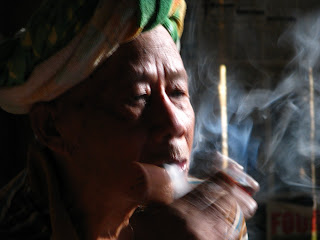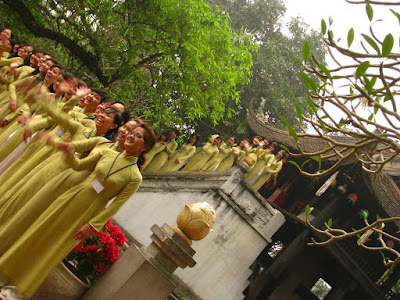.gif)
Mandalay, Myanmar (Burma) is an uneventful city 361 days a year.
But without planning on doing so, we happened to reach Mandalay for its wildest, most invigorating and ludicrous annual blowout: a four-day Water Festival marking the Myanmar New Year.
In the heart of the city are about 5 massive Water Festival stages, each surrounded by massive sound systems and each rigged with hundreds – literally hundreds – of neon hoses. The day we arrived in Mandalay, the officials turned the nozzles on. From that moment, pandemonium erupted.

Hundreds of locals leapt up on stage, grabbed a hose, and began spraying the street below. For every hose that was dousing the street, there were at least 10 more people below, dancing in the showers. There were young people and old people; men and women, drunk and sober. The one trait they shared in common is that they were all really, really wet. The temperatures in Mandalay were forecasted to reach 108 degrees that week, but no one cared. Businesses were closed. Schools were on holiday. The city morphed into a water park. And everyone was dancing in the streets.
Within minutes, the streets began to flood. The water ran off towards the curb and stayed there, clogging the city drains. It stood an inch deep, then two inches, then finally knee-deep, at which point small children decided that it was the closest thing to a swimming pool they’d ever seen, and began hurling themselves like cannonballs into the street water.

People carry empty water bottles, refilling it with all the water pouring from overhead or from the puddles down below, dump it onto the head of the nearest person, and repeat.
Teenagers take the opportunity to punk themselves out. They wear black hoodies with mesh lining. They spike their naturally black hair, then add purple or blue dye to the tips of their Mohawks. They draw dark circles around their eyes. The women wear electrifying red lipstick. The boys drink so much whiskey their bloodshot eyes soon match the girl’s lips.
The teens load themselves into the backs of their friends Jeeps and pickup trucks, packed in more tightly than sardines. Slowly they cruise through the mosh pit, getting soaked to the bone.

The water in the bed of the pickup truck grows ankle-deep. The interior of the open-top Jeeps get drenched. The driver doesn’t seem to mind. He alternately either sits behind the wheel or darts out of the car, grabs another friend on the sidewalk, shakes his hand, chats, chugs a whiskey, remembers that he left his car running in the middle of the road with 25 people in the back, and darts back to the driver’s seat again.
We go out into the street and – as obvious foreigners in a land almost devoid of visitors – become instant celebrities. We feel and act like politicians, always shaking people’s hands, getting photos taken with their babies at their request.
Our initiation begins as we walk towards the city center. We make it about 5 feet outside the hotel door before a young child runs up to us, splashes a bucket of ice-cold water onto us, and runs off. We step off the hotel stairs and onto the sidewalk. Another kid gets us in the face with a supersoaker. We turn left and begin walking. A grown man runs up to me, grabs the collar of my t-shirt, and pours a cup of water down my neck.

And so it continues, every step of the way, for five or six very wet blocks, until we reach the real scene of the spraying.
We know we’re getting close when we begin to see men lying face-up in the gutter, unconscious from too much alcohol. Then the blare of the music hits our ears. It sounds just like the past three decades of American rock music – The Cranberries, The Who – but all the words are redone in Burmese, and everyone’s singing along in a language we can’t understand.
When we get to the periphery of the crowd, locals begin to grab our shoulders and shake us.
“Are you happy?” someone yells into our faces as they shake my friend’s shoulders. “Are you happy?”
“Um, yes!,” she exclaims.
Someone else grabs my arm from behind.
“Happy!” he yells. He’s apparently either forgotten the words “Are you,” or the phrase “new years.”
There’s more of them, surrounding us, shaking our hands, grabbing our elbows. They try to speak but their words are slurred, their accents are thick, their vocab is limited.

“What your office?” someone says.
“Student,” I reply. I know better than to admit to being a journalist when I’m in a country where 1 out of every 10 people is a government spy.
“Wha our office?” he repeats.
“A student,” I say again.
“Wat our of fes?” he says. I piece it together.
“Wat our of fes …. wat-er fes … water fes! Water festival! Yes!”
The crowd around us grows thicks. Their heads wobble. My right hand is constantly being tossed from one handshake to the next. Someone is still gripping our shoulders. “Happy New Years! I love you!” the crowd screams.
And so it goes. We have dozens of conversations like this; maybe hundreds. We watch a man get on his motorcycle, but he’s too drunk to remember how to turn it on. No problem. His friend sits on the bike behind him, reaches around and grabs the handlebars. A third person gets in back and kicks the clutch. A fourth jumps onto the front of the bike. And off they ride, bouncing off the curb, onto the street which is now evenly running 6 inches deep in water.
We inch closer to the stage and water sprays directly in our eyes, our ears. We can’t see where we’re going. We can’t hear anything but the sound of George Michael’s “Wake Me Up Before You Go-Go” blaring from the speakers. I can feel someone grab my arm. “Are you happy?”

Blinking, we can faintly make out the sight of thick lines of motorcycles inching past us at hairpin-close range. If we move a split-second too quickly, or if the motorcycles misjudge us by a half-inch, we’ll end up with a nasty exhaust-pipe burn on our leg.
(In fact, several days after leaving Mandalay, while trekking through the mountains near Inle Lake, we come across a 22-year-old farmer with a third-degree exhaust-pipe burn on his leg. He hasn’t received any treatment and asks if we’re carrying a basic first aid kit. We wash his wound, clean the pus with some Q-tips, cut the scabs off with a Leatherman knife, apply some Neosporin and gauze, and tell him to go see the medicine man for some oral antibiotics. Then he shows us the gash on his hand. It’s obvious he needs stitches immediately, or he might be at risk of permanent nerve damage or even loss of limb. Already it’s gotten infected and his hand has swollen badly. We’re not equipped to handle an injury that severe, so we tell him to find a doctor; then we ask how it happened. “Water Festival,” he says, but his details are hazy.)

Deciding that being on stage, where there’s no traffic jam, is safer than being on the flooded streets, we snake around to the back fence and, with a smile, charm our way to the top row. Someone hands us neon hoses, and we let loose upon the crowd. I spot a cop trying in vain to direct traffic, and I turn the nozzle on him, spraying the officer full-force in the face. He staggers back, wipes his eyes, then tries again. This time, the woman to my right pegs him with a fire hose.
I start reflecting on festivals in America, where no one could point a fire hose directly on a crowd because of the very real possibility that the water pressure could burst someone’s ear drum. The pressure from a fire hose – for those of you who have never borne the brunt of its wrath – is unimaginably strong when fired point-blank.

Then again, if this were America, everyone would have to wear wrist bracelets indicating whether they were 21 or not. Security would be set up around the parameters. Food vendors would have to follow strict kitchen guidelines and pass a health inspection. A first-aid tent would be nearby. The guys lying unconscious in the gutter would be medically tended to, then arrested. Old ladies couldn’t sell dirt-encrusted unsealed bottles of Grand Whiskey for $1. No one could carry glass bottles into this crowd.
If this were America, this event would require parking. It would have orange cones and trash cans, police barricades and street sweepers.
In the U.S., the streets would have been designed by a road engineer, meaning they wouldn’t flood so unevenly, and the sidewalks wouldn’t have huge chunks missing where people could fall through to their waist. The motorcycle exhaust-pipes would be designed in such a way as to prevent it from burning flesh on contact.
In America, all food and alcohol vendors would need a license. They’d have to rent a booth. Here in Myanmar, anyone’s grandma can carry a pot of noodles to the festival and sell them for ten cents a bowl.
In America, companies would advertise at festivals of this size and scale. There would be corporate booths, raffles, prize giveaways. A sleek new car model would be on display. The local radio DJs would broadcast from the festival. All the beer would be sold in identical cups that bore the logos of the companies that sponsored the event.
At this festival, there was only one place with corporate logos; the stage itself. No where else were there any ads. Nor were there booths, or tents, or “Over 21” bracelets.

But then, Myanmar isn't exactly the Land of the Free.
According to the Web site of the U.S. Department of State:
"Burma (Myanmar) is an underdeveloped agrarian country ruled by an authoritarian military regime. The country's government suppresses all expression of opposition to its rule."
"The Burmese Government has a standing law ... that bans all gatherings of more than five people."
"The military regime carefully controls and monitors all internet use in Burma and restricts internet access through software-based censorship .... access to most “free” international e-mail services such as Hotmail and Yahoo is prohibited .... All e-mails are read by military intelligence."















